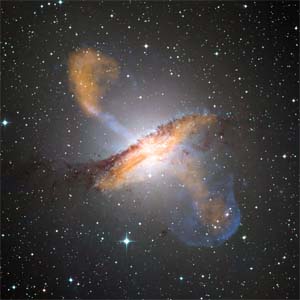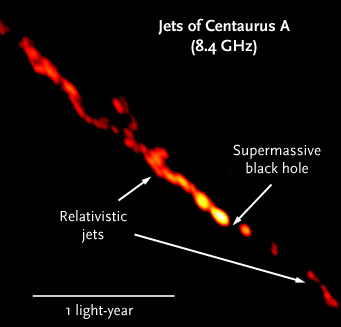There's no shortage of announcements touting the biggest/smallest, brightest/dimmest, fastest/slowest objects in the universe — along with the "best-ever this" or "most detailed that." Most of the time Sky & Telescope's editors just add them to the stack. But here's one worth passing on, because it involves what's arguably one of most interesting objects in the sky.

A combination of X-ray data (blue) from NASA’s Chandra X-ray Observatory with radio (orange) and visible-light images reveals the jets and radio-emitting lobes emanating from Centaurus A's central black hole. Click on the image for a larger view.
Visible: ESO / WFI; radio: MPI / ESO / A. Weiss & others; X-ray: NASA / CXC / R. Kraft & others
The galaxy NGC 5128 (also known as Centaurus A) is only about 12 million light-years away. It looks bright and dramatic in visible light, with a prominent dark dust lane cleaving its star ball in two. But when viewed at radio wavelengths, it lights up the sky. The galaxy's boundaries balloon to several degrees across, and its center sports a pair of opposed jets that betray the presence of a supermassive black hole in its core.
Because Cen A is the nearest active galactic nucleus, astronomers have spent a lot of time and resources trying to understand what makes it tick. For example, its nucleus is a strong source of high-energy radiation, as most recently documented by long-term observations with the Rossi X-ray Timing Explorer (RXTE) and the Fermi Gamma-ray Space Telescope. These outbursts are presumably the death throes of matter spiraling into the black hole, whose mass is about 55 million Suns.

This high-resolution radio image, acquired with an interferometric array in November 2008, reveals never-before-seen details in Centaurus A's twin jets.
TANAMI / C. Müller & others / A & A
Now cosmologists have a new probe of the galaxy's inner workings: a high-definition snapshot of the jets at two radio frequencies, 8.4 and 22.3 gigahertz, that resolves details only about 15 light-days across. The dual-freuqncy view comes from a battery of radio telescopes in Australia, South Africa, Chile, and Antarctica known as TANAMI (Tracking Active Galactic Nuclei with Austral Milliarcsecond Interferometry).
As Cornelia Müller (University of Erlangen-Nürnberg) and others describe in the June issue of Astronomy & Astrophysics, the TAMANI array resolves individual blobs and other never-before-seen details in the jets, which appear to be racing away from the core at roughly one-third the speed of light. Among the puzzling findings are that the emission peaks at the two frequencies are slightly offset from one another and that the jets can appear bright at one frequency but not the other.
To learn more about these observations, you can delve into the team's full results here, or instead check out NASA's press release here.
 1
1
Comments
George Brewer
May 24, 2011 at 1:54 pm
It's interesting the large scale structure of NGC 5128 jets appears like the theoretical clumping of electrons in a traveling wave tube.
You must be logged in to post a comment.
You must be logged in to post a comment.